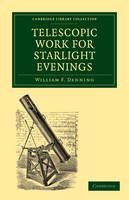
Telescopic Work for Starlight Evenings
Seiten
2010
Cambridge University Press (Verlag)
978-1-108-01413-7 (ISBN)
Cambridge University Press (Verlag)
978-1-108-01413-7 (ISBN)
First published in 1891, this book by British astronomer William F. Denning brings together a series of articles on telescopes, their history and their usage. It provides an insight into the evolution of astronomy and will be a valuable resource for historians of science and amateur astronomers.
William F. Denning (1848–1931) was a British astronomer famous for his planetary observations and meteor studies. Elected president of the Liverpool Astronomical Society in 1887, he wrote a series of articles on telescopes for the society's journal, which were brought together and republished in 1891 under the title Telescopic Work for Starlight Evenings. Intended as a contribution to popular astronomy, this book provides a varied introduction to telescopes and their usage. The opening essay traces the development of the telescope from antiquity, through Galileo and Newton's contributions in the seventeenth century, to contemporary progress in astronomy. Other chapters provide practical advice for conducting planetary observation and detailed studies of particular planets, as well as facts and figures about meteors and how to compute their orbit. This book provides a fascinating insight into the evolution of astronomy and will be a valuable resource for historians of science and amateur astronomers.
William F. Denning (1848–1931) was a British astronomer famous for his planetary observations and meteor studies. Elected president of the Liverpool Astronomical Society in 1887, he wrote a series of articles on telescopes for the society's journal, which were brought together and republished in 1891 under the title Telescopic Work for Starlight Evenings. Intended as a contribution to popular astronomy, this book provides a varied introduction to telescopes and their usage. The opening essay traces the development of the telescope from antiquity, through Galileo and Newton's contributions in the seventeenth century, to contemporary progress in astronomy. Other chapters provide practical advice for conducting planetary observation and detailed studies of particular planets, as well as facts and figures about meteors and how to compute their orbit. This book provides a fascinating insight into the evolution of astronomy and will be a valuable resource for historians of science and amateur astronomers.
1. The telescope, its invention and the development of its power; 2. Relative merits of large and small telescopes; 3. Notes on telescopes and their accessories; 4. Notes on telescopic work; 5. The Sun; 6. The Moon; 7. Mercury; 8. Venus; 9. Mars; 10. The planetoids; 11. Jupiter; 12. Saturn; 13. Uranus and Neptune; 14. Comets and comet-seeking; 15. Meteors and meteoric observations; 16. The stars; 17. Nebulae and clusters of stars; Notes and additions; Index.
| Erscheint lt. Verlag | 29.7.2010 |
|---|---|
| Reihe/Serie | Cambridge Library Collection - Astronomy |
| Zusatzinfo | 2 Plates, black and white; 65 Halftones, black and white |
| Verlagsort | Cambridge |
| Sprache | englisch |
| Maße | 140 x 216 mm |
| Gewicht | 490 g |
| Themenwelt | Sachbuch/Ratgeber ► Natur / Technik ► Weltraum / Astronomie |
| ISBN-10 | 1-108-01413-5 / 1108014135 |
| ISBN-13 | 978-1-108-01413-7 / 9781108014137 |
| Zustand | Neuware |
| Haben Sie eine Frage zum Produkt? |
Mehr entdecken
aus dem Bereich
aus dem Bereich
die Suche nach der Urkraft des Universums
Buch | Hardcover (2023)
Klett-Cotta (Verlag)
CHF 34,95
Perspektiven auf die Menschheit
Buch | Hardcover (2024)
Klett-Cotta (Verlag)
CHF 34,95


